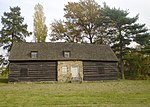Tinicum Township, Delaware County, Pennsylvania
AC with 0 elementsCensus-designated places in Delaware County, PennsylvaniaCensus-designated places in PennsylvaniaPennsylvania populated places on the Delaware RiverTownships in Delaware County, Pennsylvania ... and 1 more
Townships in Pennsylvania

Tinicum Township, more popularly known as "Tinicum Island" or "The Island", is a township in Delaware County, Pennsylvania, United States. The population was 4,091 at the 2010 census, down from 4,353 at the 2000 census. Included within the township's boundaries are the communities of Essington and Lester. One of the island's notable aspects is the John Heinz National Wildlife Refuge at Tinicum, attracting visitors to the island year-round. The international terminal, the western end of the airfield, and runways 9L/27R and 9R/27L of Philadelphia International Airport are located in Tinicum Township.
Excerpt from the Wikipedia article Tinicum Township, Delaware County, Pennsylvania (License: CC BY-SA 3.0, Authors, Images).Tinicum Township, Delaware County, Pennsylvania
South Governor Printz Boulevard, Tinicum Township
Geographical coordinates (GPS) Address Nearby Places Show on map
Geographical coordinates (GPS)
| Latitude | Longitude |
|---|---|
| N 39.870833333333 ° | E -75.2825 ° |
Address
South Governor Printz Boulevard
South Governor Printz Boulevard
19113 Tinicum Township
Pennsylvania, United States
Open on Google Maps







